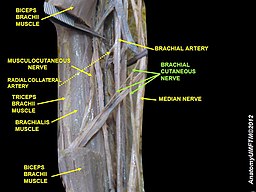Introduction
The Musculocutaneous nerve is a large branch of the Brachial Plexus that supplies the flexors of the arm and sensation to the lateral forearm.
General Course of Nerve
The Musculocutaneous nerve is a terminal branch of the lateral cord of the Brachial Plexus. It emerges at the inferior border of Pectoralis minor muscle. It has root values of C5, C6 and C7. It leaves the axilla to then pierce the Corocobrachialis near it humeral insertion. It then travels laterally down the arm, superficial to the Brachialis but deep to the Biceps Brachii muscle. It terminates 2cm above the elbow as the Lateral Cutaneous nerve of the forearm.
Branches
Motor branches are to
- Corocobrachialis
- Brachialis ( also has supply from Radial nerve)
- Biceps Brachii
Sensory branches are
- the terminal Lateral Cutaneous nerve to the lateral forearm
Articular branches
Movements produced
- Coracobrachialis – flexs and adducts the glenohumeral (GH) joint and acts to stabilise the humeral head in the glenoid fossa when the arm is hanging freely by side.[2]
- Brachialis- flexion of the elbow joint.
- Biceps Brachii- a weak abductor of GH joint when arm externally rotated. Weak flexor of GH joint. Helps to stabilise GH joint when weight carried in arm. A supinator and flexor of the elbow joint.[3]
Pathology/Injury[4][5]
Isolated injuries of the Musculocutaneous Nerve are rare. It may become injured by
- Brachial Plexus damage
- Compression injury eg weight lifting or sports involving lots of forarm flexing and supination.The biceps aponeurosis and tendon compress against the fascia of the brachialis muscle causing sensory loss below the elbow on the lateral side of the forearm.
- Dislocation of the shoulder
- Shoulder surgery
- Entrapment of the nerve at the elbow
Anatomical Variations
Considerable anatomical variations present with this nerve. This may lead to clinical implications in eg surgery, diagnosis.[4]
Physiotherapy Techniques
Examination
Check strength of Biceps Brachii, Corocobrachialis and Brachialis muscles .
Check sensation on lateral forearm
Check for Differential Diagnoses- namely C5/6 Radiculopathy; biceps Brachii distal insertion tear.
Physiotherapeutic Techniques
References
- ↑ Osama Eqeel. Musculocutaneous nerve. Available from: ↑ Wikipedia. ↑ Wikipedia. ↑ 4.04.1 Patient. ↑ Healthline. function gtElInit() { var lib = new google.translate.TranslateService(); lib.setCheckVisibility(false); lib.translatePage('en', 'pt', function (progress, done, error) { if (progress == 100 || done || error) { document.getElementById("gt-dt-spinner").style.display = "none"; } }); }

